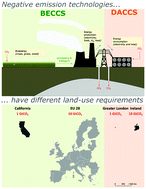The mutual dependence of negative emission technologies and energy systems†
Abstract
While a rapid decommissioning of fossil fuel technologies deserves priority, most climate stabilization scenarios suggest that negative emission technologies (NETs) are required to keep global warming well below 2 °C. Yet, current discussions on NETs are lacking a distinct energy perspective. Prominent NETs, such as bioenergy with carbon capture and storage (BECCS) and direct air carbon capture and storage (DACCS), will integrate differently into the future energy system, requiring a concerted research effort to determine adequate means of deployment. In this perspective, we discuss the importance of energy per carbon metrics, factors of future cost development, and the dynamic response of NETs in intermittent energy systems. The energy implications of NETs deployed at scale are massive, and NETs may conceivably impact future energy systems substantially. DACCS outperform BECCS in terms of primary energy required per ton of carbon sequestered. For different assumptions, DACCS displays a sequestration efficiency of 75–100%, whereas BECCS displays a sequestration efficiency of 50–90% or less if indirect land use change is included. Carbon dioxide removal costs of DACCS are considerably higher than BECCS, but if DACCS modularity and granularity helps to foster technological learning to <100$ per tCO2, DACCS may remove CO2 at gigaton scale. DACCS also requires two magnitudes less land than BECCS. Designing NET systems that match intermittent renewable energies will be key for stringent climate change mitigation. Our results contribute to an emerging understanding of NETs that is notably different to that derived from scenario modelling.



 Please wait while we load your content...
Please wait while we load your content...